QuestionQUESTION: Help! This is moving very fast! Since my last email both large bumps on Bubba's head have "popped". The white substance is all gone now and the one under is eye is a ragged hole and the smaller one just looks ragged. We have had him 3 years and he's never been sick. He's always been a chow hound, ate good this morning, doesn't want to eat tonight. This really has me worried. He has a shimmy behavior in one corner and sometimes darts around the tank likes he angry. I gave another salt treatment (1 tbsp. per 5 gallons, and Melefix. Could it be Columinaris, Hole in Head or Fungus? Also, I notice my Nitrates are high tonight: 50 ppm. Are water changes more important than salt and meds? Should I do a water change and forget the salt and meds for now? I'm really panicked, I don't want to lose another fish. Paula
ANSWER: Hi Paula,
The shimmying behavior you describe is indicative of a water quality issue. Unlike ammonia or nitrite, nitrates don't just shoot up all of a sudden, they have probably been building for some time - nitrates are the end product of the nitrogen cycle. As I mentioned previously, a large water change (50%) and gravel vacuuming should have been executed before either the medication or the salt treatment began. Meds are very toxic when there is ammonia presence - when you said your water levels were acceptable, bear in mind that some test kits say that .25 ppm is "safe". This is just not true. A healthy, cycled tank never shows any ammonia or nitrite, only nitrate. Nitrate should always stay below 20 ppm, as close to zero as possible.
A water change is definitely in order to bring those nitrates down (and all other levels to 0 ppm flat, if they are not there already). The water change will remove the salt - but this is not an issue, you can just add it back. Keep track of how much water you change and you will know just how much needs to be added back. You can do a 20% water change per day, you can even do more than one. When a fish has an exposed wound, clean water is absolutely the most important aid to healing. Medications are useless unless the water quality is optimal. Do 2x 20% water changes per day, if you need to, to bring the nitrates down below 20 ppm.
Hole in the Head is actually HLLE (Head and Lateral Line Erosion) and not a disease where an actual hole appears in the head. Type HLLE into Google.com and see for yourself.
Columnaris is possible, but much more likely is that the shimmying is a response to water quality. You should see a drastic improvement with daily 2x water changes. Often times, folks believe that with medication, water changes will negate the effects - not so. If 5 gallons of water are changed in a 10 gallon tank, certainly half the amount of medication that was removed can be reapplied to the new water, and the same with the aquarium salt. Just keep up those water changes until nitrates are below 20 ppm. A Furan compound (such as Fungus Clear or Furan-2) would be my suggestion after the treatment for ich. You should purchase the Furan compound of your choice, but do not use it at this point, just observe, and keep the water quality high.
Don't panic...when in doubt, always do a water change! It never hurts and very often helps.
Nicole
---------- FOLLOW-UP ----------
QUESTION: Hi Nicole,
One more quick question. I have tried 2 different gavel vacuums from my local pet store and neither have worked. Can you recommend one that actually does?
Thanks, Paula
ANSWER: Hey Paula,
So glad to hear things are looking up. Goldfish are very hardy, I believe your oranda will soon rally. May I make a suggestion? Your oranda may just not feel like eating when you offer food, but that's not to say it may not like to graze on a bit of something. Try sinking sliced veggies with a magnetic clip and leaving them for a few hours to see if there is any interest. Most goldfish absolutely love live plants such as Elodea, but romaine lettuce works too, and many also enjoy cucumbers, and squash such as yellow squash and zucchini. The veg will not cloud your water and will be an available option if your oranda gets the munchies.
Lots of info on goldfish feeding available here:
http://www.wetwebmedia.com/FWSubWebIndex/gldfshfdgfaqs.htm
Especially the article, essentially on goldfish malnutrition and the related buoyancy issues, called "Bloaty Floaty Goldfish" and linked at the top in blue. Have a look when you get a chance. Best to you, and thanks for taking the time to rate all of the answers! Myself and all of the other Experts sincerely appreciate that courtesy very much.
Nicole
---------- FOLLOW-UP ----------
QUESTION: Nicole,
I do have an Elodea plant in the tank, I need to replace it though so I started offering romaine, spinach, zucchini and cucumber as well as a slice of orange (too messy though) when I brought Bart home (the new one). Bubba liked the lettuce, spinach and especially the orange. Too bad it made such a mess. But then he lost interest. He really still has no interest in eating and rests mostly but then darts around the tank in obvious stress. Working his mouth like he is gulping. Did I mention he has very long stringy poop and sometimes fibrous. I noticed the strings in the tank after I brought Bart home and I thought it was him. Guess not! I've been VERY careful what I feed since my ordeal with my other fish Tweety (Damaged swim bladder). Could this be connected to his infection. His face looks like it is already healing but his behavior and poop still have me worried. The last solid poop we saw was during our water change last night. It shot out and was at the beginning of a very long white stringy and fibrous string. (Ick, great discussion, sorry!) I am still doing water changes but have not medicated the tank further. All that salt seemed to bring all this on, probably just a coincidence. I do have some Jungle Tank Buddies Fungus Clear and Parasite Clear on hand but I haven't
AnswerHi Paula,
Using the salt treatment to eradicate ich is stressful for the affected fishes - we're talking the upper limits of salt that are tolerable for them. The sullen behavior and lack of appetite is not unusual, but the white stringy feces and heavy breathing you describe are classic symptoms intestinal parasites, assuredly unrelated to the salt application.
You sound like you really care about your pets, Paula. Without knowing your maintenance schedule, I don't want to fault you of letting the water quality degrade (and you have been doing a fantastic job with the water changes lately!) but poor water quality is really the #1 reason intestinal parasites and ich are allowed to take hold in an aquarium. Ammonia and nitrites at 0 ppm is a given, but high nitrates cause all sort of troubles, including dropsy. A dirty filter or stale gravel can be a real nitrate trap. Cleaning either of these can result in appreciable drops in nitrates within a few hours, without performing additional water changes.
The #2 reason is failure to quarantine new additions. I do understand how inconvenient it may seem to set up a separate tank and keep the new addition separated for 1 week or longer, but this really is so helpful in assessing the health of the new fish. I do believe Bart was carrying some unpleasants that have now affected your (possibly older?) oranda. Why Bart seems to be experiencing no symptoms, I do not know, but the entire tank is still infected with ich, even if the cysts presented themselves only on Bubba. You are taking steps to eliminate it, and I commend you. But do know that a quarantine tank can be as simple as a bare-bottomed 10 gallon tank. Just keep a sponge filter (such as the kind made by Hydro, check thatpetplace.com) running in your main tank, move it over to the QT when you are ready to use it, and that in itself will provide all the biological filtration necessary for a brief week's worth of quarantine or so. Break down the QT/hospital tank when not in use, so it won't be in the way. It's simple, really!
Gravel vacuuming is extremely helpful in keeping the water clean, the pH buffered (since detritus in the gravel drives down pH as it decomposes) and helping to break the ich life cycle in an affected tank. It's odd to me that the vacs you've bought don't work... but anyhow, keeping the gravel clean in a goldfish tank is really a must. I'm sorry, I can't remember how large your tank was if you told me, I've had more questions than usual lately and it's hard for me to remember all the specs. Needless to say a smaller tank, while easier to break down and clean, is really more trouble in the long run. Let me know how large your tank is again. Your problems might stem just from this issue alone. If ever you do upgrade (unless you've got a 55 gallon right off the bat, that is ample room for both your fellas) you can always use your other tank for quarantine. I had a questioner some months back who bought a 90 gallon tank for her 3 orandas and used her 29 gallon for a hospital tank. She was having all sorts of trouble with her 29 gallon goldfish setup - fin rot, ich, the usual ailments. The upgrade must have put an end to that, because I haven't heard from her since.
Sorry, let me get to the point! I believe your ich ordeal really is coming to a close. Although medicated food is by far the safest way to treat effectively, if Bubba continues his hunger strike, this won't do. A few drops of pure garlic oil (or a commercial prep like Garlic Xtreme or Garlic Guard) may entice him to eat, you could try it, and apply it to a medicated pellet with Metronidazole in it - such as Anti-Bacteria made by Jungle, and available at Petsmart.
I suspect that until you are entirely over the ich episode and have performed enough water changes to get things back to "normal" along with vacuumed the gravel (give the non-working vacs another go! try holding the vac at an angle with the tank) and just let the healer of all things, time, go by - you just may not be able to get Bubba to feel like eating normally. If this is the case, a Parasite Clear bath in a separate container might be necessary. These fizz tabs also contain Metro as the active ingredient. I strongly suggest using the separate container and giving him soaks for a couple hours a day, since your biological filtration is already tenuous due to all that salt. Keep this in mind, but just wait for now. Do not use the Fungus Clear, I do not believe a fungal infection ever took hold since his open wounds appear to be healing, thanks to your water changes!
The intestinal parasite outbreak is a serious condition, however. Keep a close eye on Bart's feces too. If you do get your fellas to eat, a food I've not had personal experience with, but have heard rave reviews about from a number of experts, is Anti-Protozoa flake by Florida Guppies Plus:
http://flguppiesplus.safeshopper.com/256/cat256.htm?258
Like Jungle's Anti-Parasite, the active ingredient is Metronidazole, but these flakes are more palatable and of a higher quality than the pellets made by Jungle. Feeding this flake as the exclusive prepared food for a week, along with the usual complements of fresh vegetables for grazing, has had, in my reading experience, nothing short of miraculous results with demanding fish such as wild Angelfish that are often imported already infested with intestinal parasites.
I hope that does give you some ideas. Take care, and thank you for being so conscientious and caring. If only everyone cared so much about their pet fishes! Your hard work will pay off sooner than later, I assure you.
Nicole

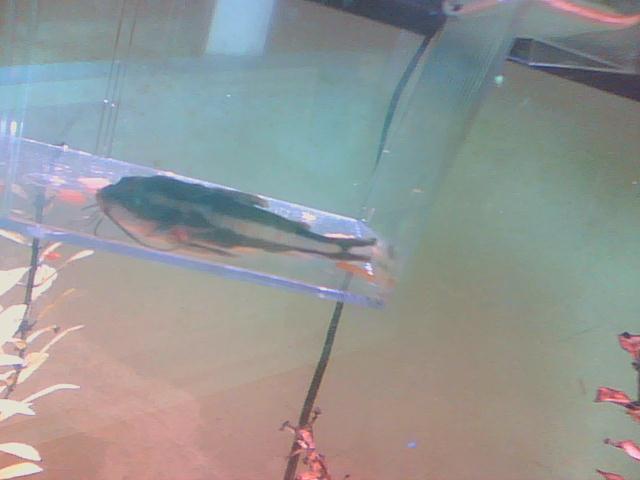 Half-dead fish
Question
Picture of my fish
I have a bottomfeeder whos
Half-dead fish
Question
Picture of my fish
I have a bottomfeeder whos
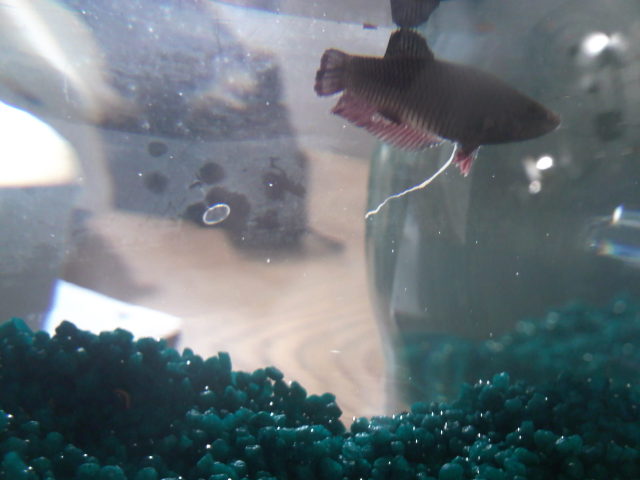 My betta has a white tube hanging,is it sick?
Question
Hanging White tube
Last week I bought a femal
My betta has a white tube hanging,is it sick?
Question
Hanging White tube
Last week I bought a femal
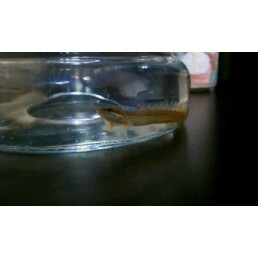 dyno fish
Questioni thinks its called a
QUESTION: i just
dyno fish
Questioni thinks its called a
QUESTION: i just
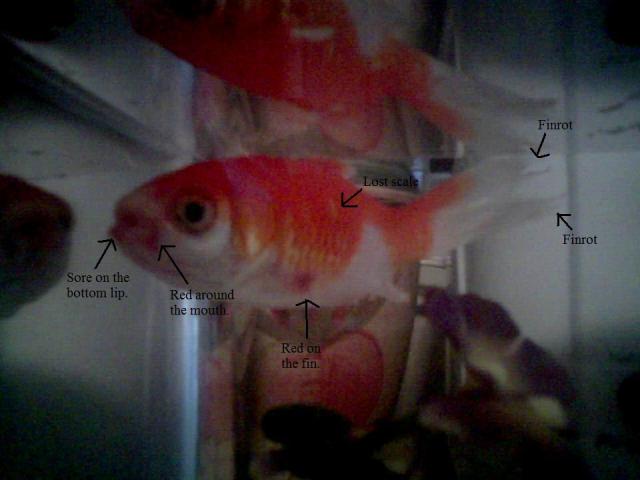 My goldfish is sick.
QuestionSick fish
QUESTION: My goldfish is sick
My goldfish is sick.
QuestionSick fish
QUESTION: My goldfish is sick
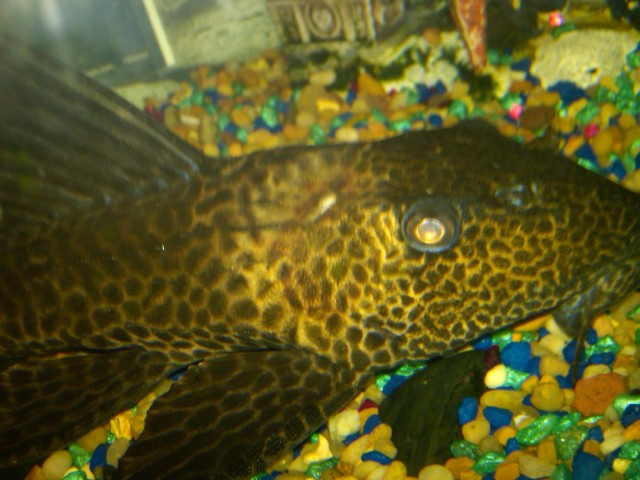 My 4 year old Platys
QuestionQUESTION: It has developed a gash on the back o
My 4 year old Platys
QuestionQUESTION: It has developed a gash on the back o